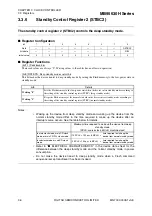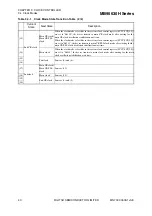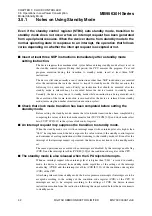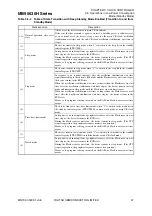
MB95630H Series
MN702-00009-1v0-E
FUJITSU SEMICONDUCTOR LIMITED
49
CHAPTER 3 CLOCK CONTROLLER
3.5 Operations in Low Power Consumption
Mode (Standby Mode)
3.5.3
Stop Mode
In stop mode, the main clock, the main CR clock, the main CR PLL clock and
the subclock are stopped.
■
Operations in Stop Mode
In stop mode, the main clock, the main CR clock, the main CR PLL clock and the subclock are
stopped. In this mode, while retaining the contents of registers and RAM existing at the point
immediately before the device transits to stop mode, the device stops all functions except
external interrupt and low-voltage detection reset.
As for hardware watchdog timer, if it is enabled in standby mode by the non-volatile register
function, in stop mode, the sub-CR clock does not stop and the hardware watchdog timer
continues its operation. For details, see "CHAPTER 26 NON-VOLATILE REGISTER (NVR)
●
Transition to stop mode
Writing "1" to the stop bit in the standby control register (STBC:STP) causes the device to
transit to stop mode. At that point, if the pin state setting bit in the standby control register
(STBC:SPL) is "0", the states of the external pins are kept; if the SPL bit is "1", the states of
the external pins become high impedance (a pin is pulled up if the pull-up resistor connection
for that pin is selected in the pull-up register).
●
Release from stop mode
The device is released from stop mode by a reset or an external interrupt. In any clock mode, if
the hardware watchdog timer is enabled in standby mode by the non-volatile register function,
the sub-CR clock does not stop, and the watchdog timer and the watch prescaler operate in stop
mode. The device can also be released from stop mode by an interrupt from the watch
prescaler. For details, see "CHAPTER 26 NON-VOLATILE REGISTER (NVR)
With the deep standby mode control bit (STBC2:DSTBYX) set to "0", after a reset occurs or an
interrupt is generated by a peripheral function, the device executes different operations,
depending on the relation between the oscillation stabilization wait time and the Flash recovery
wait time as explained below.
•
When the oscillation stabilization wait time is shorter than the Flash recovery wait time
After the oscillation stabilization wait time elapses, the device transits to sleep mode and
remains in sleep mode until the Flash recovery wait time elapses.
•
When the oscillation stabilization wait time is longer than the Flash recovery wait time
After the oscillation stabilization wait time elapses, the device returns to the RUN state.
However, if a program is being executed on the RAM, no Flash recovery wait time occurs.















































